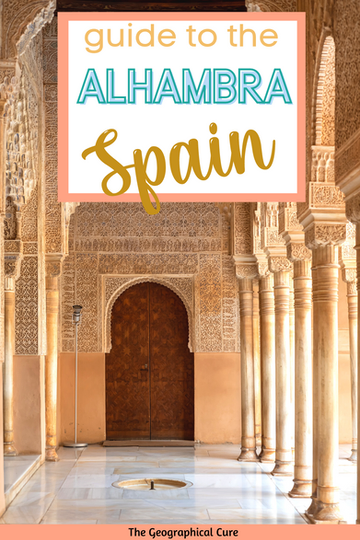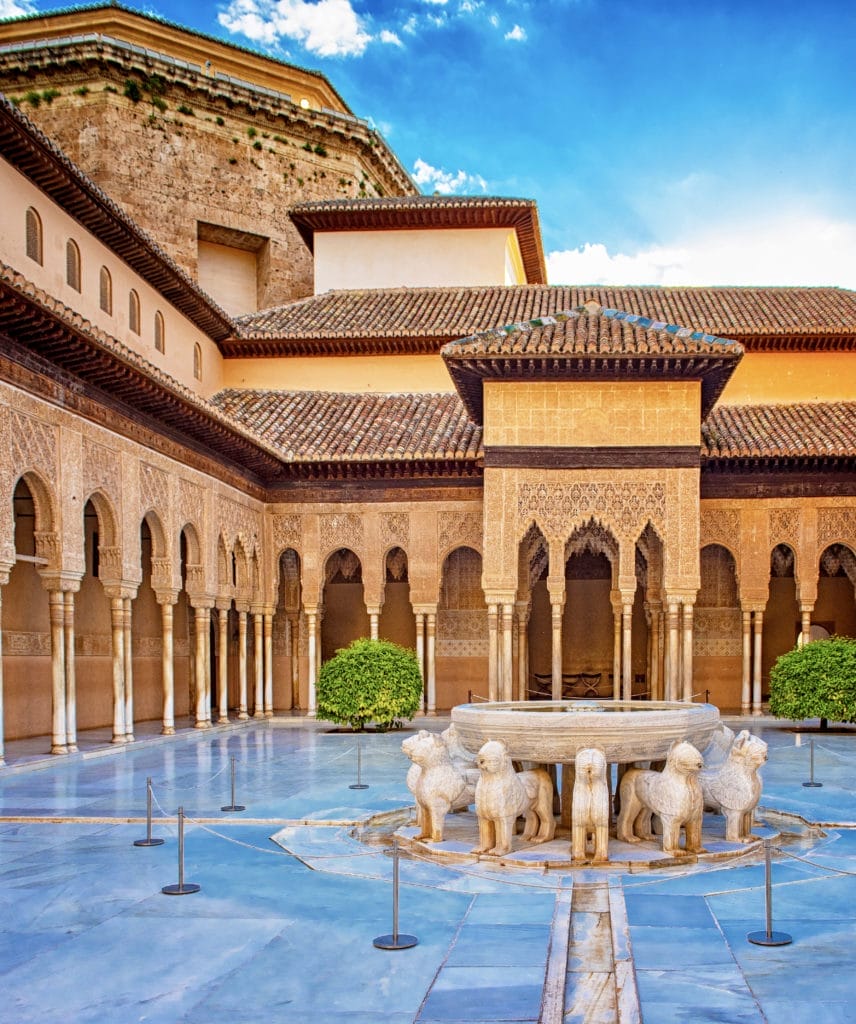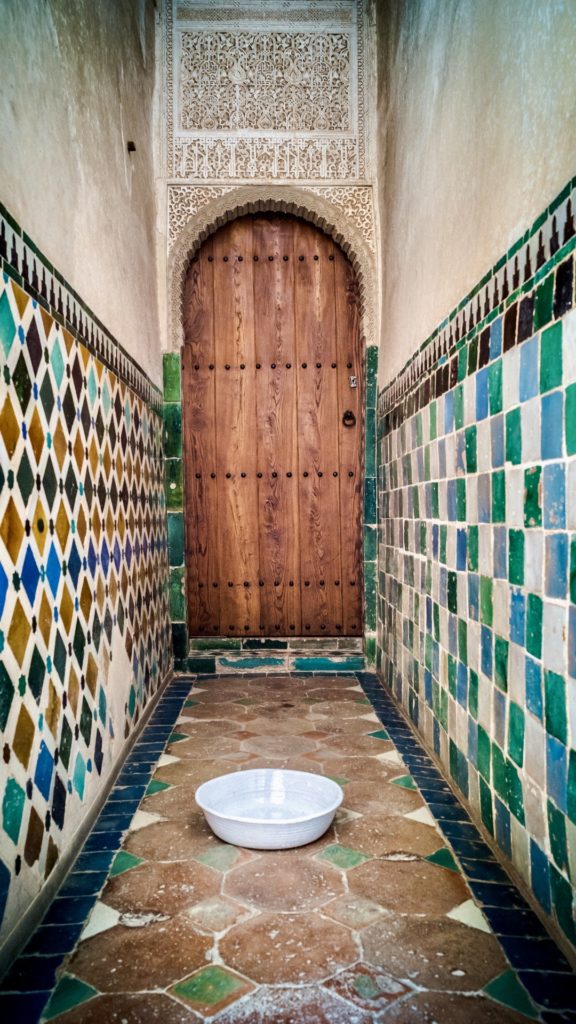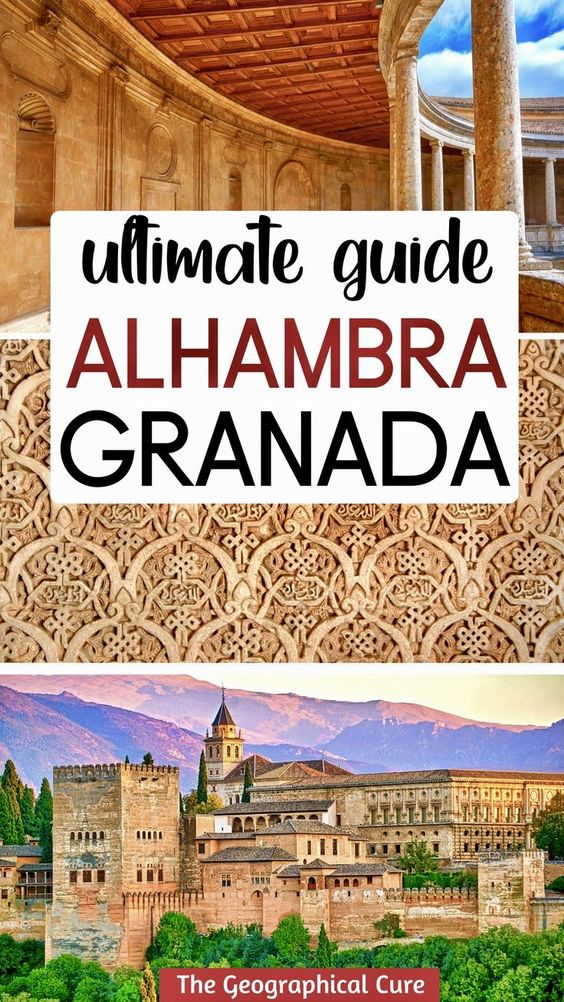Planning a visit to the magnificent Alhambra? You’re in for a treat! This Alhambra guide covers everything you need to see and do, from the mighty Alcazaba to the ornate Nasrid Palace to the stunning Generalife Gardens.
In addition to highlighting the top sites, this guide also includes essential tips for visiting the Alhambra. As one of Europe’s most popular destinations, tickets can sell out quickly, so it’s important to plan ahead.
You can’t just show up at the Alhambra and ricochet around the site. You need a plan of attack and prepaid entry tickets.
The Alhambra is the world’s last and greatest Moorish fortress. The Alhambra reflects the opulence of the Moorish imagination.
Every room is decorated top to bottom with carved wooden ceilings, scalloped stucco, patterned ceramic tiles, and filigree windows.
The Alhambra sits on a stunning piece of real estate – a high, mountainous location on Sabika Hill with sweeping views over Granada and the surrounding countryside

In the Moorish tradition, it’s decorated with water: “standing still, cascading, masking secret conversations, and drip-dropping playfully.”
Alhambra became a UNESCO site in 1984. It’s a deeply affecting place.
The Alhambra is so beautiful and enchanting, it’s difficult to process. Or to unglue your camera from your face.
Don’t miss the chance to experience the beauty and history of the Alhambra. Follow this guide to make the most of your visit to this incredible landmark in Spain.

Tickets & Tours For The Alhambra
You can buy a ticket on the Alhambra website. I tell you how in the tips section at the end of the article. But it’s rather clunky and tickets may well be sold out.
If so, you can buy a skip the line ticket on Get Your Guide or a ticket on Viator. Don’t wait too long because these sell out too.
You may want to book a guided tour of this magnificent UNESCO site. Tours are also another way to nab the valuable ticket. They also sell out fast.
Here are some guided tour options:
- a 2.5 hour small group guided tour
- a 3 hour private tour
- a 3 hour tour of the Alhambra and Generalife Gardens
- a 3 hour tour with a historian
- a 2 hour night visit
- a 6 hour tour of the Alhambra and the highlights of Granada
Guide To The Alhambra: What To See
The Alhambra spans nearly 26 acres, with more than a mile of walls, 30 towers and many smaller structures.
After you enter at the main ticket office, you stroll down the Calle Real de la Alhambra, past the ruins of the Medina.
There are four main attractions inside the Alhambra: (1) the Nasrid Palace; (2) the Charle’s V Palace, (3) the Alcazaba, and (4) the Generalife Gardens.
You can see the sites in any order. If you want to walk a direct route, you’ll start with the Alcazaba and Charles V’s Palace and then proceed to the Nasrid Palace.
Just make sure to organize your tour around your fixed entry time for the palace. If you miss it, you won’t be allowed in later.
1. The Alcazaba
What is an Alcazaba, you might be wondering? Alcazaba is an Arabic word that means castle or fort.
The Alcazaba’s primary function was defense and shelter from external attacks. It was also a miniature city within a city, lodging the sultans’ guards.
The fortress is one of the oldest parts inside the Alhambra. It possibly pre-dated the arrival of the Muslims. The first historical reference dates from the 9th century. The current fortress was built by Mohammed I in the 13th century.
The entrance to the Alcazaba is Arms Square. In the middle of the square are the remains of Arab residences. Near the Broken Tower, there’s a large dungeon.
Arms Square was devoted to military parades during peacetime and to defensive strategy in wartime. For this reason, it’s an open space with few buildings.
The Alcazaba’s defining features are its ramparts and three towers: the Broken Tower (Torre Quebrada), the Keep (Torre del Homenaje), and the Watch Tower (Torre de la Vela).
You can venture up and around all the towers.
The Watch Tower is the main tower of the Alcazaba. Its name derives from the bell hung in its tallest tower. It is rung on great occasions of state.
From the tower, you have incomparable views over the Albayzín and the Sierra Nevada Mountains. This is the chief glory of the Alcazaba.
Arms Tower is located on the northern ramparts. It has a long rectangular projection, which also makes for great viewing. For centuries, it was the main entry to the Alcazaba.
2. Charles V Palace
In 1526, as conquering kings are prone to do, Charles V built his own palace in the Alhambra. He respected the beautiful Nasrid Palace and left it intact.
Instead, Charles built a fancy Renaissance-style Palace for official functions. He used the existing Nasrid Palace as his residence.
The Renaissance palace is lovely. But it stands out like a sore thumb amidst all the elegant Moorish architecture.
Nevertheless, the palace is Spain’s most impressive Renaissance building. It has a circle within a square design and a two tiered colonnade. Try standing in the center; it is an impressive sight.
The Palace was meant to have a dome. But Charles’ son abandoned the project. instead, he built his own massive palace outside Madrid.
The Alhambra Museum is on the south side of the ground floor of the Charles V Palace. The museum houses a collection of tiles, pottery, and lion fountains.
The Fine Arts Museum is on the top floor of the palace with Granadian sculptures and paintings from the 15th to 20th centuries.
3. Nasrid Palace
The Nasrid Palace is undoubtedly the crown jewel of the Alhambra. It’s well-preserved and well-restored. The palace offers the finest example of the refined, intricate, and elegant architectural style of the Moorish civilization.
The photogenic palace is a harmonious masterpiece of light, space, and water built out of brick, wood and stucco. Every inch of the rooms are decorated, top to bottom, with ceramic tiles, elaborate plaster work, calligraphy, filigreed windows, and stucco stalactite ceilings.
Originally, the palace was painted in bright colors — red, blue, green, and gold. But the colors faded over time.
There are three basic sections to the palace: royal offices, ceremonial rooms, and private quarters. You begin by walking through the Mexuar, the administrative rooms.
Then you walk into the large rectangular Courtyard of the Myrtles, which is a showstopper.
Courtyard of the Myrtles
The Courtyard of the Myrtles is one of the most famous and beautiful courtyards in the Alhambra. In the center is a shimmering 150 foot pool lined with myrtle hedges. The pool reflects the intricate plaster tracery of the gallery arches.
The gallery has a standard Moorish design. It’s decorated with intricate plasterwork and colorful tiles, including the famous 16th century azulejos (blue and white ceramic tiles) with geometric patterns.
At each end are colonnades with exquisitely carved arches. The courtyard served as a cool place to relax in the sweltering Andalusian summers.
Grand Hall of the Ambassadors
Head left through an antechamber and you arrive in the Grand Hall of the Ambassadors. It is the largest room in the Alhambra, 37 feet square and 75 feet tall.
This was the ornate throne room for the Moorish sultans. Its main aim was to impress. Here, the sultans, seated on their thrones, received visitors, vassals, and foreign emissaries.
The ceiling is extremely elaborate and suggests the complexity of the universe. It was constructed using 8,000 small cedar wood pieces to make a delicate mosaic, which conjures the image of a star-scattered night sky.
The ornamental detail in the room is stunning. Consistent with Muslim traditions, there is no figurative artwork.
Rather, the designs consist of religious messages, plant life, floral patterns, and calligraphy.
In 1492, two historic events occurred in this room.
First, Boabdil officially surrendered to King Ferdinand and Queen Isabella.
Second, Christopher Columbus made his first pitch to the conquering Reconquistas. He asked them to finance his sea voyage to the Orient.
Most courtiers were skeptical and thought Columbus had underestimated the size of the world. But Queen Isabella was not. She authorized his madcap voyage of discovery.
Palace of the Lions
The Palace of the Lions was built by Mohammed V and was the residence of the royal family.
A beautiful arched gallery supported by 124 columns surrounds its 14th century rectangular Courtyard of the Lions.
This is probably the most iconic part of the Nasrid Palace. The best photo shots are from the Mocarabes Gallery.
Mohammed V built the alabaster fountain in the 1360. It has a complex hydraulic system consisting of a marble basin on the backs of twelve carved stone lions situated at the intersection of two water channels that form a cross.
The four water channels symbolize the four rivers of paradise. The lions, all with different faces, are a symbol of power and courage. They were cleaned and restored in 2010.
The courtyard connects to the Hall of the Abencerrajes. This is perhaps my favorite part of the whole Alhambra because of its incredible ceiling.
Hall of the Abencerrajes
The Hall of Abencerrajes was the sultans’ living room, and it’s a stunner.
It has perhaps the most exquisite ceiling in the Nasrid Palace, based on an eight sided Mulim star in blue, brown, red, and gold colors.
The name of the room comes from a gruesome legend. Sultan Moulay Hacén, the father of Boabdil, took a new wife and wanted to disinherit his prior children.
To ensure they didn’t rise to seize power, the sultan killed 30 family members. It’s said that he stacked their heads up in the pool under the ceiling. The reddish color in the hall’s fountain is purportedly stained by the bloodshed.
Hall of the Kings
This room is undergoing renovation. But you’ll only be able to see parts of it.
In a palace otherwise devoid of figures, this room offers a rare glance at life in the palace. There are paintings depicting courtly life, including the sultans, hunting scenes, and shootings scenes.
The Hall of the Kings is divided into three square spaces with porticos in the center. These spaces are perpendicularly segmented by large double stalactite arches.
Hall of the Two Sisters
The Hall of the Two Sisters is nicknamed for the massive slabs of white marble on the floor. You enter via a well preserved wood den with a semicircular festooned arch.
It’s a typical royal bedroom with a lovely view of the Courtyard of the Lions and the Gardens of the Partal.
The hall has yet another spectacular ceiling, carved in the 16th century. The dome is lit by lateral windows. It evokes an exquisite flower.
Royal Baths
The Royal Baths are known as El Bano de Comares. They’re the only fully intact medieval bath in the Western World.
The baths were used by the Catholic kings as their private bathing area in the 15th century.
This area is often closed to visitors because of its fragile and delicate state. But you can see parts of the baths from a gallery corridor. The ceiling has star shaped openings, which were used to regulate the temperature and steam.
There’s also beautiful Alicatado tile work in cobalt blue, green, gold, and white colors. The Alicatado style is a mosaic formed of polygonal glazed tiles in geometric patterns.
Peinador de la Reina
The Peinador de la Reina is the queen’s dressing room. This space is a complete contrast to other places in the Nasrid Palace.
It was built in 1537 for the Empress Isabel (Charles V’s wife) after the conquest of Granada.
The room is set high in what was formerly the Tower of Abu I Hayyay. One corridor is open to the landscape, with spectacular views over the Albayzin neighborhood.
The walls are painted with Italian style frescos by Julio Aquiles and Alexander Mayner. There are military scenes depicting an expedition of Charles V. And there are other decorative motifs — flowers, animals, and angels.
Unfortunately, this area is closed to public visitors. You can only see it on a private tour.
Partal Palace
The Partal Palace was built in the early 14th century.
It’s also known as the Portico Palace because of the portico formed by a five arched arcade at one end of a large pool. Above the arches are Arabic signs of delicacy and complexity.
It is one of the oldest palace structures in the Alhambra complex. Only a fragment of the original palace still stands.
Leaving the palace, climb a few stairs and follow signs directing you to the Generalife Gardens.
4. Generalife Gardens
The Nasrid sultans didn’t limit themselves to building within Alhambra’s ramparts. Just beyond the walls lie the Generalife Gardens, one of the best preserved Nasrid estates.
The gardens are also known as the Architect’s Gardens, which may be a translation of the term Generalife. I think they’re best left for last, so you can relax and reflect after all the architectural magnificence.
Generalife was the lush leisure villa of the last dynasty of Moorish sultans. They spent their summers here to escape the intense heat. Generalife is considered one of Europe’s most beautiful formal gardens.
The gardens are thought to date from the 13th century. At that time, they contained orchards and vegetable gardens. The current gardens, however, date to 1931, when they were restored as part of the ongoing renovation of the Alhambra.
The Generalife comprises a lower garden, the palace residence, and upper gardens. A simple one way path guides you through the gardens.
Terraced gardens, cloisters, pools, and fountains combine to enchanting effect. Even in winter, the gardens are quite beautiful, complete with cypress trees, pomegranate trees, hedgerow mazes, fountains, flowers, and elaborate irrigation systems.
Make sure to seek out the Escalera del Auga, or Water Stairway. Its bannisters double as little water canals or luges.
At the top of the Water Stairway, you will reach the highest point of the Generalife Gardens and enter its bright white palace, the Court of la Acequia.
The palace is essentially an enclosed oriental garden built around a long central pool. The pulsing fountains, while a delight, are from the 19th century. At the end of the pond, you enter the sultans’ three room summer retreat.
While it has some Moorish flourishes, the overall effect is somewhat different than other parts of the Alhambra complex.
From the last room, there are steps to the upper level and the Renaissance gardens, circa 1600.
There are amazing views of the entire Alhambra complex and the town of Granada behind it.
While strolling the gardens, you will also find a modern outdoor theater with a cypress-lined stage. It’s still a concert venue for Granada.
The Alhambra is a remarkable, immense place. The atmosphere inside is weightier than the words I use to describe it.
The elegant Moorish artistry is more glorious than the photographs I present to show it. The whole experience is quite overwhelming. The splendor of the Moorish civilization shines brightly.
Don’t miss the experience if you are visiting Andalusia!

If you aren’t staying in Granada, you can visit the Alhambra on a day trip from another city.
You can book a 7 hour day trip from Malaga. Or an 11 hour day trip tour from Seville.
Practical Guide & Tips for Visiting the Alhambra
Here are some things to know about visiting the Alhambra.
Before you visit, you may want to read the Alhambra official visitor guide. A youtube guide to the design and architecture of the Alhambra is here.
You can print a map of Alhambra here and this is a guide to understanding the layout.
1. Address
Albayzín neighborhood, Calle Real de la Alhambra, s/n, 18009 Granada
2. Getting there:
By Foot: from Plaza Nueva, it’s about a 20-25 minute steep hike
By Taxi: It’s a 7 euro taxi ride from the taxi stand in Plaza Nueva
By Bus: Just uphill from the Plaza de Isabel La Catolica, catch a red #C30 or #C32 minibus marked Alhambra, which leave every 8-12 minutes
By Car: Parking is onsite near the main entrance at Camino Viejo del Cementerio, 2A, 18009 Granada
3. Entry Fees:
The Alhambra General ticket is 19 euros. This is the only ticket that allows you to see the Nasrid Palace during the day.)
It’s best to purchase your ticket online up to 3 months in advance of your visit. Order tickets online here.
There are three types of tickets for sale: day ticket, garden ticket, and night ticket.
4. Step By Step Process for Buying an Alhambra Ticket Online:
If you’re a planner, Alhambra tickets can be purchased up to a year in advance. Here’s the way to do it online:
- 1. Visit the official Alhambra ticketing site
- 2. Choose your preferred ticket option
- 3. Select the type of ticket you need. Children under 12 need a ticket even though entry is free
- 4. Select the date and time you wish to enter the Nasrid Palace
- 5. Enter your personal details, including your passport number
- 6. Make payment
- 7. Print your tickets at home or collect them from the ticket office
- 8. If you already have a printed ticket, you can enter at the Puerta de la Justica, instead of the main entrance
5. Picking up tickets at the Alhambra:
It’s easiest to print your tickets at home. If you pick your ticket up at Alhambra, go to the main entrance to the windows marked “Retired de Reserves” or use the Ticketmasters machines in the pavilion behind the bookstore.
Allow yourself 30 minutes to pick up your ticket and walk to the Nasrid Palace.
6. Plan Your Time At The Alhambra
Alhambra General tickets are sold with a specific 30 minute time slot for admission to the Nasrid Palace. 300 people enter every 30 minutes.
You must enter the Palace within the window or you will be denied entrance. The guards are strict.
There’s often a long queue, so get to the Nasrid Palace line at least 20 minutes before your designated admission time. In high season, you may need to line up 60 minutes in advance.
Once you enter the Alhambra complex via the main entrance, it’s a 15 minute walk to the Nasrid Palace entrance.
7. Opening Hours
Entire complex: Open daily from 8:30 am to 8:00 pm. From mid-October through March: 8:30 am to 6:00 pm. The ticket office opens at 8:00 am.
8. Where To Stay In Granada
The Eurostars Catedral is a lovely hotel housed in a 16th century manor, just a short walk from the cathedral. The Catalonia Granada is a lovely hotel that comes complete with a plunge pool and open air terrace.
Hotel Palacio de Santa Paula is a historic high end hotel in a former 16th century convent. If you want to stay right in the Alhambra complex, check out the Hotel Alhambra Palace, with ornate decor and viewing points.
If you want a place where tradition and avant garde style meet, check out the stunning Hospes Palacio de los Patos. It’s housed in a UNESCO-listed palace, with sprawling gardens, a spa, and mosaic floors.
I hope you’ve enjoyed my guide to the Alhambra. You may enjoy these other Spain travel guides and resources:
- One Day in Granada Itinerary
- 30+ Secret Towns in Spain
- Most Beautiful Places in Andalusia
- Six 1 Week Itineraries for Spain
- 10 Day Road Trip From Madrid To Seville
- 10 Day Itinerary for Basque Spain
- 10 Day Itinerary From Barcelona to Bilbao
- 3 Day Itinerary for Seville
- 3 Day Itinerary for Barcelona
- 40+ Landmarks in Barcelona
- 2 Day Itinerary for Bilbao
- 2 Day Itinerary for Madrid
- Famous Landmarks in Spain
If you’d like to visit the Alhambra in Granada, pin it for later.


Great article thank you for all the detail and history!
Thank you!
Thank you so much for the detailed description. This is a wonderful article.
May I know if there are descriptions in English throughout the compound of Alhambra?
Best regards,
Lei
No, I don’t recall seeing any signage of note … You need to get the audio guide in English. Enjoy Lei!